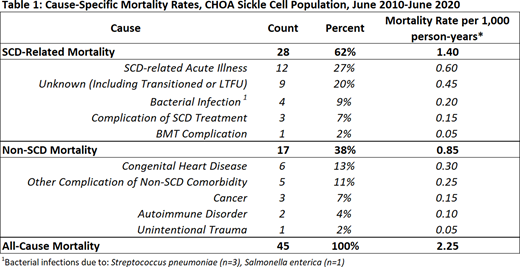
Background
Mortality rates and causes of death in children with sickle cell disease (SCD) have changed significantly over the past several decades. With ongoing improvements in standards of care, modern mortality estimates must be updated. Children's Healthcare of Atlanta (CHOA) houses one of the largest pediatric SCD programs in the country. This analysis reviews mortality in children with SCD who were treated at CHOA between June 2010-June 2020.
Methods
We reviewed the CHOA's Sickle Cell Clinical Database (SCCD) for deceased patients. Demographics, SCD genotype, date and age at death, healthcare utilization, hydroxyurea (HU) use, chronic transfusion therapy (CTT), and bone marrow transplant (BMT) were obtained from the SCCD. Cause of death and history of significant comorbidities were abstracted from the medical record. Mortality rates were calculated using person-time for all CHOA SCD patients and population-based mortality was obtained from CDC WONDER Online Database.
Results
A total of 3,698 patients with SCD were seen at CHOA from June 2010-June 2020 and accounted for 19,998 person-years. Of the 46 patients who died during that time, all but 1 patient had been seen in the CHOA Sickle Cell Outpatient Clinic at least once. That patient received SCD care at a different institution, died from complications of a non-SCD related disease following transfer to CHOA, and was excluded from analysis. Of the 45 remaining patients (178 person-years), the majority were sickle cell anemia genotypes (n=37, 82%; Hb SS or Hb S β0 thalassemia), followed by Hb SC (n=5, 11.1%) and Hb S β+ thalassemia (n=3, 6.7%); 53% (n=24) were female. The average age at death was 12.8 years (1.0-22.8 years).
Twenty-one (46.7%) patients had ever been treated with HU and 11 (24.4%) were currently on HU at the time of last contact (either death or last CHOA encounter). Eleven (24.4%) patients had ever been treated with CTT, and 3 (8.9%) were being treated with CTT at time of last contact. In comparison, during the same time period an average of 58% and 12% of the overall CHOA SCD population were being treated with HU and CTT, respectively. Forty-one patients had at least 1 SCD-related encounter at CHOA within 12 months prior to death. For the 4 patients who had not been seen at CHOA within 12 months, the average time since last contact was 1.72 years (1.03 - 2.7 years). Eighty percent (n=8) of the 10 patients who died at age >19 had either recently transitioned to adult care or had documentation of a transition plan.
During this 10-year period, the crude death rate was 2.3 per 1,000 person-years. The majority of deaths (62%, n=28) were attributable SCD-related causes and corresponded to a cause-specific mortality rate of 1.40 per 1,000 person-years. The remaining 38% (n=17) of deaths were caused by complex non-SCD comorbidities or accidental trauma and corresponded to a non-SCD related mortality rate of 0.85 per 1,000 person-years. In comparison, the mortality rate for African American persons age <22 in Georgia from 2009-2018 was 0.9 per 1,000 person-years.
Of the 28 patients who died due to an SCD-related cause: 12 (27%) experienced an acute illness related to SCD, 4 (9%) succumbed to acute bacterial infections, 3 (7%) died from complications of SCD treatment (1 procedure-related, 2 drug-induced hemolytic anemia), and 1 (2%) died from complications of BMT. Nine (20%) had either recently transitioned to adult care or were lost to follow-up and had no significant non-SCD comorbidities, therefore cause of death was unknown. Of the 17 non-SCD related deaths, 16 (36%) were due to complex non-SCD comorbidities (including cancers, autoimmune disorders, and congenital heart disease) and 1 (2%) from an accidental trauma.
Conclusions
To our knowledge, this is the largest and most recent study of mortality in patients with SCD from a single institution. Overall, the demographics of deceased patients were similar to those of the CHOA SCD population as a whole. This cohort indicates that trends in mortality of children with SCD have largely shifted away from bacterial infections to other complications of SCD, subsequent treatments, or comorbidities. Our data confirm that patients nearing transition to adult care are at high risk of mortality. This study is limited to deaths that are known to the CHOA system, so future analyses will expand this cohort to include data from death certificates and CDC's National Death Index.
Lane:FORMA Therapeutics: Membership on an entity's Board of Directors or advisory committees; Global Blood Therapeutics: Membership on an entity's Board of Directors or advisory committees.
Author notes
Asterisk with author names denotes non-ASH members.

This icon denotes a clinically relevant abstract


